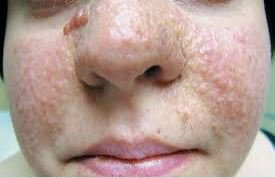A 48 y.o. male with sickle cell anemia was found unconscious with a temp of 38.6.
What do you notice on his CT?
there appears to be a basal ganglia bleed; but what is going on in the lower image?
Our patient had Moyamoya syndrome. On the CTA there was diffuse narrowing of of the internal carotid arteries and intracranial arteries. Moyamoya means “puff of smoke” and originally described a genetic condition where narrowed arteries lead to abnormal collateral networks of small arteries which develop adjacent to the stenotic vessels. Often the Circle of Willis is involved
The abnormal arteriogram of an 11 y.o. is on the L, the normal is on the R
The disease is thought to be genetic with some families having 10% of their members affected .Three cases are found for 100,000 people in Japan where the incidence is highest. Familial moyamoya is autosomal dominant with incomplete penetrance. People with moyamoya have been found to have elevated thyroid antibodies and immunity may play a role in the expression of the disease.
There are two conditions called moyamoya: moyamoya disease; a rare genetic disease found first in the Japanese population and moyamoya syndrome; diffuse sclerosis and narrowing of vessels caused by many conditions. These lead to the same problem, bleeding from multiple collateral arteries.
angiofibromas are associated with tuberous sclerosis and moyamoya
DISEASES ASSOCIATED WITH MOYAMOYA which should prompt a CTA when patients present with stroke symptoms.
Immunologic-Graves disease
Infections- Leptospirosis, tuberculosis
Hematologic- Sickle cell anemia, lupus anticoagulant
Congenital syndromes- neurofibromatosis, Down’s, marfans, tuberous sclerosis
Vascular disease- atherosclerosis
areas of hypopigmentation first described by Ito are associated with a genetic form of moyamoya
Death from moyamoya is usually associated with hemorrhage. 50-60% of people have a decline in cognitive function due to strokes. moyamoya should be considered in any patient with a stroke.
Treatment is limited to anticoagulation which puts people at risks for future bleeding or anastomosis of arteries which are larger to narrowed intracranial arteries like a superficial temporal artery to middle cerebral artery anastomosis. In children because of the small diameter o the superficial temporal artery, the arachnoid membrane can be divided and the superficial temporal artery placed directly on the pial membrane. It is not clear if these procedures improve long-term outcomes.
Our patient expired.
Janda P, Bellew , Veerappan V. Moyamoya disease: case report and literature review. J Am Osteopath Assoc 2009 Oct. 109(10):547-53.
Kim S, Heo K, Shin H, et al. Association of thyroid autoantibodies with moyamoya-type cerebrovascular disease: a prospective study. Stroke. 2010 Jan 41(1):173-6.
Tomaszewska M, Strzelczuk-Judka L, Ostalska-Nowicka D. et al. Phakomatoses and cutaneous manifestations associated with moyamoya disease and syndrome. Postepy Dermatol Alergol 2020 Dec: 37(6):831-835.
Echenne B, Leboucq N, Humbertclaude V. Ito hypomelanosis and moyamoya disease. Case Reports Pediatr neurol. 1995 Sep;13(2):169-71.




